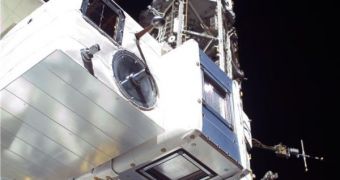The $100-billion International Space Station (ISS) is a project so valuable to the scientific community, and indeed to the whole world, that keeping it safe was among the top priorities engineers had in mind when constructing it. Armor plates adorn its sides, so that the entire structure can resist impacts from microasteroids, and man-made space debris. Still, it would have been a pity to spend years in orbit with analyzing these objects' destructive power. Hence, DEBris In-orbit Evaluator-2 (DEBIE-2) appeared.
This sensor unit, made up of ten by ten cm aluminum-foil panels, was attached to the exterior of the ISS, and arranged in such a manner that each of them pointed in a different direction than the others – forward in the direction of orbit, upwards and sideways out to space, AlphaGalileo reports. The entire ensemble is connected to a separate data-processing unit, to which it relays telemetry data of the impact events it suffers while the station cruises above the Earth at seven kilometers per second.
“One of the surprises we have found so far is that impact events come in clusters and are not randomly distributed. These peaks can be concentrated within the space of perhaps a minute to 80 seconds at a time, indicating the existence of clouds of dust along the ISS’ orbit,” the Principal Investigator of the DEBIE-2 instrument, ESA Space Environment & Effects Section expert Gerhard Drolshagen, says of the finds made so far. Such a device mounted on the ISS is of extreme importance, because an estimated 13,000 objects larger than ten centimeters in diameter exist around the planet.
Each of these objects travels at speeds that allow it to puncture through solid steel in a heartbeat. Needless to say, the walls of the ISS are not made out of solid steel, because, if they were, its construction would have taken a lot more than a decade. Analyzing the potential effects that a collision with a rogue object might have on the lab's structural integrity is, therefore, a major objective.
“We’re [...] considering a bigger detector capable of getting information on bigger particles in the future. Around 0.5 mm is where you start to be really concerned; that size could cut a wire or damage the soft part of an astronaut’s spacesuit,” Drolshagen concludes.

 14 DAY TRIAL //
14 DAY TRIAL //